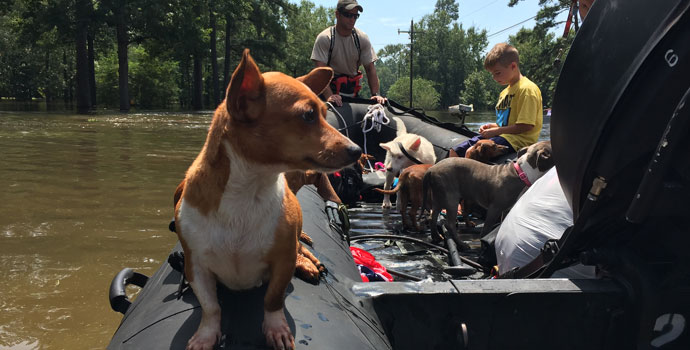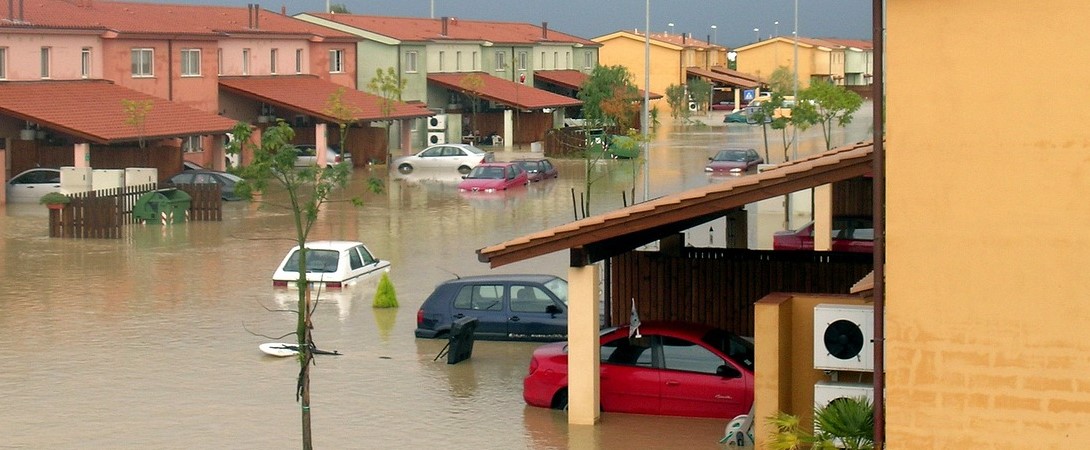From Katrina To Harvey: Helping Companion Animals In Disasters
In 2005, Hurricane Katrina hit the southeastern United States. The media showed countless pictures and videos of dogs standing on roofs as raging waters rushed by and cats swimming in toxic rivers. As waters flooded their homes, thousands of people refused to evacuate without their companion animals and refused to heed rescuers’ instructions to leave their companion animals behind. As a result, people passed away because they stayed behind with their animals, and many companions passed away as well.
Unfortunately, Hurricane Katrina was a learning moment for emergency management organizations. It showed that the lives of humans and animals are intertwined and that officials must look at the family unit as a whole when approaching disaster response. Shortly after Hurricane Katrina, significant reforms in the U.S. were created to include household pets and service animals in disaster relief plans and to afford them with better protection during natural disasters. The PETS – Pets Emergency and Transportation Standards – Act, established in 2006, was one such reform.
Disaster struck again in 2017 as Hurricane Harvey hit the Gulf states. Efforts to ensure that the mistakes of Hurricane Katrina, including leaving companion animals behind, would not happen again. Still, officials questioned if they had learned anything from Hurricane Katrina and whether the reforms previously established, such as the PETS Act, made a difference.
In 2017, a study was undertaken to answer these questions. Six individuals, representing organizations who had a major role in leading animal rescues during Hurricane Harvey, were asked if the PETS Act had made any positive impacts after Hurricane Katrina and what lessons were learned afterwards. The respondents had memories of Hurricane Katrina and remarked that the evacuation of companion animals, alongside their human families, is now not only necessary, but should be expected. Hurricane Katrina was a turning point. Katrina made it clear that Americans have deeply embraced the idea of dogs and cats as family members and that they need to be included during all evacuations.
However, the respondents also stated that major improvements regarding planning, coordination, and implementation after Katrina and the PETS Act had been established were yet to occur. In fact, the respondents were not aware that there were even any animal emergency plans in effect at the state, county or city levels, only drafts of plans prepared. The additional major areas of concern included:
- None of the organizations interviewed had any animal emergency management training.
- None of the animal welfare groups had a dedicated emergency manager.
- Spontaneous animal volunteer groups acted outside of any emergency management system, had no record keeping, and took animals out of state never to be reunified with their owners.
- An excessive volume of donated goods that were inappropriate, used, or expired caused much distraction and organization time during evacuations.
- “Disaster rustling” was a common occurrence. Individuals would arrive at an animal shelter reporting to be the owner of an animal, especially horses, without the animal being chipped and having no form of identification.
- There were no standardized forms or databases for evacuated or displaced animals. In areas where microchipping is not common, these databases are crucial.
- Due to displaced animals, animal hoarders used Hurricane Harvey as an opportunity to re-stock their animal numbers and to stock up on animal supplies.
- There was a lack of effective organization, lack of knowledge regarding large-scale incident management, and lack of communication between external organizations and local shelters and veterinarian clinics.
If there is anything positive to take away from the trials and tribulations of Hurricane Katrina, it is that companion animals are no longer viewed as property. They are now viewed as members of society. Additionally, the PETS Act was wildly cheered as a major step forward in how companion animals are treated and protected during disasters. However, as can be seen by this study, improvements during emergency responses are still needed, especially in the areas of planning and coordination.
For animal advocates, the list of concerns should be instructive. Since animal volunteer groups are named as potentially adding to the chaos of an already chaotic situation, advocates should take note, and try to better coordinate their rescue activities with those of other emergency management groups. If animal advocates are better able to work with human disaster relief efforts, the results will be better for everyone.
https://www.mdpi.com/2076-2615/8/4/47

















